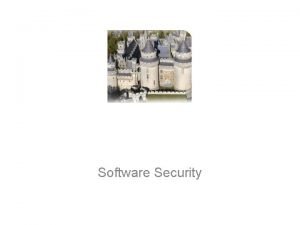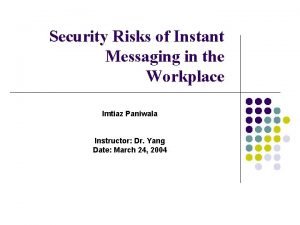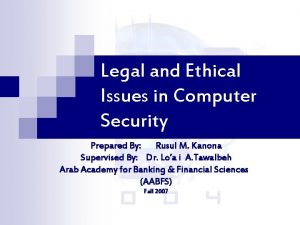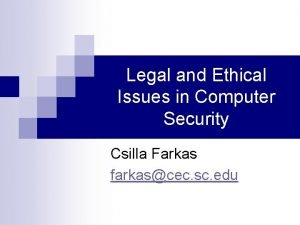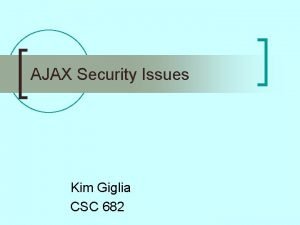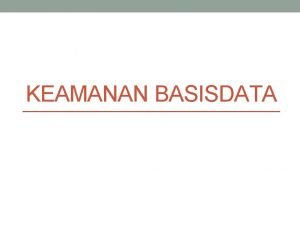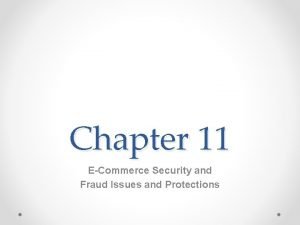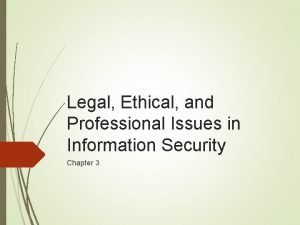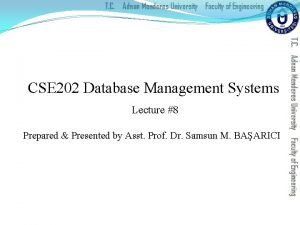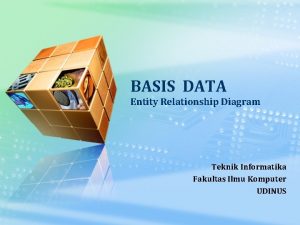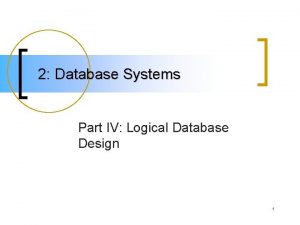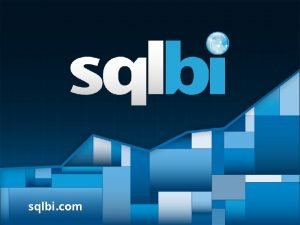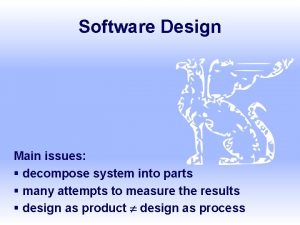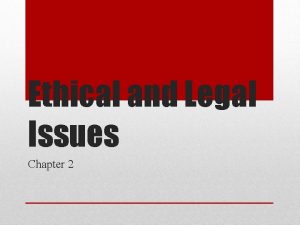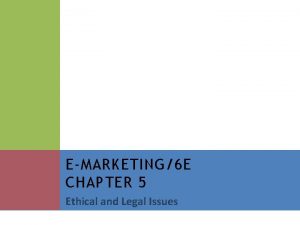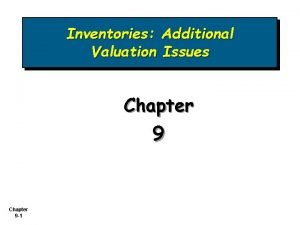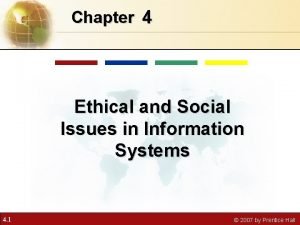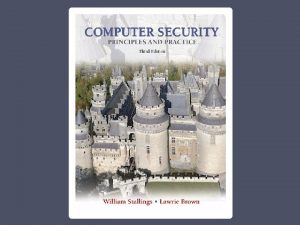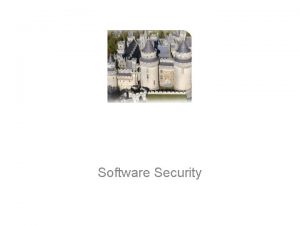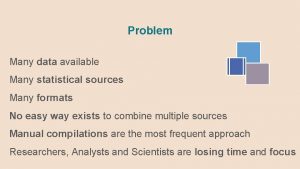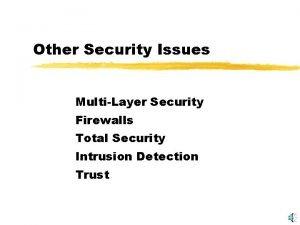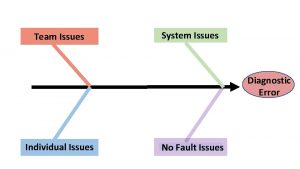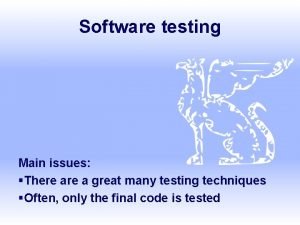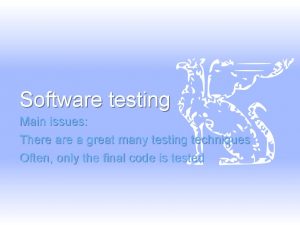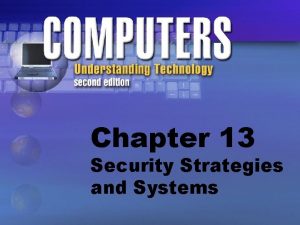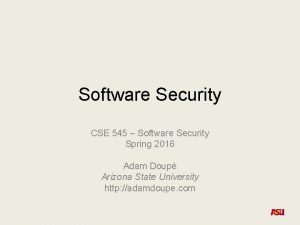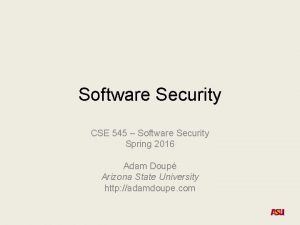Chapter 11 Software Security Software Security Issues Many











































- Slides: 43


Chapter 11 Software Security

Software Security Issues • Many vulnerabilities result from poor programming practices • Consequence from insufficient checking and validation of data and error codes o Awareness of these issues is a critical initial step in writing more secure program code Software error categories: • Insecure interaction between components • Risky resource management • Porous defenses

Table 11. 1 CWE/SANS TOP 25 Most Dangerous Software Errors (2011)

Software Security, Quality and Reliability • Software quality and reliability: o Concerned with the accidental failure of program as a result of some theoretically random, unanticipated input, system interaction, or use of incorrect code o Improve using structured design and testing to identify and eliminate as many bugs as possible from a program o Concern is not how many bugs, but how often they are triggered • Software security: o Attacker chooses probability distribution, specifically targeting bugs that result in a failure that can be exploited by the attacker o Triggered by inputs that differ dramatically from what is usually expected o Unlikely to be identified by common testing approaches

Defensive Programming • Designing and implementing software so that it continues to function even when under attack • Requires attention to all aspects of program execution, environment, and type of data it processes • Software is able to detect erroneous conditions resulting from some attack • Also referred to as secure programming • Key rule is to never assume anything, check all assumptions and handle any possible error states


Defensive Programming • Programmers often make assumptions about the type of inputs a program will receive and the environment it executes in o Assumptions need to be validated by the program and all potential failures handled gracefully and safely • Requires a changed mindset to traditional programming practices o Programmers have to understand how failures can occur and the steps needed to reduce the chance of them occurring in their programs • Conflicts with business pressures to keep development times as short as possible to maximize market advantage

Security by Design • Security and reliability are common design goals in most engineering disciplines • Software development not as mature • Recent years have seen increasing efforts to improve secure software development processes • Software Assurance Forum for Excellence in Code (SAFECode) o Develop publications outlining industry best practices for software assurance and providing practical advice for implementing proven methods for secure software development

Handling Program Input Incorrect handling is a very common failing Input is any source of data from outside and whose value is not explicitly known by the programmer when the code was written Must identify all data sources Explicitly validate assumptions on size and type of values before use

Input Size & Buffer Overflow • Programmers often make assumptions about the maximum expected size of input o Allocated buffer size is not confirmed o Resulting in buffer overflow • Testing may not identify vulnerability o Test inputs are unlikely to include large enough inputs to trigger the overflow • Safe coding treats all input as dangerous

Interpretation of Program Input • Program input may be binary or text o Binary interpretation depends on encoding and is usually application specific • There is an increasing variety of character sets being used o Care is needed to identify just which set is being used and what characters are being read • Failure to validate may result in an exploitable vulnerability • 2014 Heartbleed Open. SSL bug is a recent example of a failure to check the validity of a binary input value

Injection Attacks • Flaws relating to invalid handling of input data, specifically when program input data can accidentally or deliberately influence the flow of execution of the program Most often occur in scripting languages • Encourage reuse of other programs and system utilities where possible to save coding effort • Often used as Web CGI scripts




Cross Site Scripting (XSS) Attacks Commonly seen in scripted Web applications Attacks where input provided by one user is subsequently output to another user • Vulnerability involves the inclusion of script code in the HTML content • Script code may need to access data associated with other pages • Browsers impose security checks and restrict data access to pages originating from the same site Exploit assumption that all content from one site is equally trusted and hence is permitted to interact with other content from the site XSS reflection vulnerability • Attacker includes the malicious script content in data supplied to a site


Validating Input Syntax It is necessary to ensure that data conform with any assumptions made about the data before subsequent use Input data should be compared against what is wanted Alternative is to compare the input data with known dangerous values By only accepting known safe data the program is more likely to remain secure

Alternate Encodings May have multiple means of encoding text Unicode used for internationalization • Uses 16 -bit value for characters • UTF-8 encodes as 1 -4 byte sequences • Many Unicode decoders accept any valid equivalent sequence Growing requirement to support users around the globe and to interact with them using their own languages Canonicalization • Transforming input data into a single, standard, minimal representation • Once this is done the input data can be compared with a single representation of acceptable input values

Validating Numeric Input • Additional concern when input data represents numeric values • Internally stored in fixed sized value o 8, 16, 32, 64 -bit integers o Floating point numbers depend on the processor used o Values may be signed or unsigned • Must correctly interpret text form and process consistently o Have issues comparing signed to unsigned o Could be used to thwart buffer overflow check

Input Fuzzing • Developed by Professor Barton Miller at the University of Wisconsin Madison in 1989 • Software testing technique that uses randomly generated data as inputs to a program o o Range of inputs is very large Intent is to determine if the program or function correctly handles abnormal inputs Simple, free of assumptions, cheap Assists with reliability as well as security • Can also use templates to generate classes of known problem inputs o Disadvantage is that bugs triggered by other forms of input would be missed o Combination of approaches is needed for reasonably comprehensive coverage of the inputs

Writing Safe Program Code • Second component is processing of data by some algorithm to solve required problem • High-level languages are typically compiled and linked into machine code which is then directly executed by the target processor Security issues: • Correct algorithm implementation • Correct machine instructions for algorithm • Valid manipulation of data

Correct Algorithm Implementation Issue of good program development technique Algorithm may not correctly handle all problem variants Consequence of deficiency is a bug in the resulting program that could be exploited Initial sequence numbers used by many TCP/IP implementations are too predictable Combination of the sequence number as an identifier and authenticator of packets and the failure to make them sufficiently unpredictable enables the attack to occur Another variant is when the programmers deliberately include additional code in a program to help test and debug it Often code remains in production release of a program and could inappropriately release information May permit a user to bypass security checks and perform actions they would not otherwise be allowed to perform This vulnerability was exploited by the Morris Internet Worm

Ensuring Machine Language Corresponds to Algorithm • Issue is ignored by most programmers o Assumption is that the compiler or interpreter generates or executes code that validly implements the language statements • Requires comparing machine code with original source o Slow and difficult • Development of computer systems with very high assurance level is the one area where this level of checking is required o Specifically Common Criteria assurance level of EAL 7

Correct Data Interpretation • Data stored as bits/bytes in computer o Grouped as words or longwords o Accessed and manipulated in memory or copied into processor registers before being used o Interpretation depends on machine instruction executed • Different languages provide different capabilities for restricting and validating interpretation of data in variables o Strongly typed languages are more limited, safer o Other languages allow more liberal interpretation of data and permit program code to explicitly change their interpretation

Correct Use of Memory • Issue of dynamic memory allocation o Used to manipulate unknown amounts of data o Allocated when needed, released when done • Memory leak o Steady reduction in memory available on the heap to the point where it is completely exhausted • Many older languages have no explicit support for dynamic memory allocation o Use standard library routines to allocate and release memory • Modern languages handle automatically

Race Conditions • • • Without synchronization of accesses it is possible that values may be corrupted or changes lost due to overlapping access, use, and replacement of shared values Arise when writing concurrent code whose solution requires the correct selection and use of appropriate synchronization primitives Deadlock o Processes or threads wait on a resource held by the other o One or more programs has to be terminated

Operating System Interaction • • Programs execute on systems under the control of an operating system o Mediates and shares access to resources o Constructs execution environment o Includes environment variables and arguments Systems have a concept of multiple users o Resources are owned by a user and have permissions granting access with various rights to different categories of users o Programs need access to various resources, however excessive levels of access are dangerous o Concerns when multiple programs access shared resources such as a common file

Environment Variables • • Collection of string values inherited by each process from its parent o Can affect the way a running process behaves o Included in memory when it is constructed Can be modified by the program process at any time o Modifications will be passed to its children Another source of untrusted program input Most common use is by a local user attempting to gain increased privileges o Goal is to subvert a program that grants superuser or privileges administrator


Vulnerable Compiled Programs can be vulnerable to PATH variable manipulation • Must reset to “safe” values If dynamically linked may be vulnerable to manipulation of LD_LIBRARY_PATH • Used to locate suitable dynamic library • Must either statically link privileged programs or prevent use of this variable

Use of Least Privilege escalation • Exploit of flaws may give attacker greater privileges Least privilege • Run programs with least privilege needed to complete their function Determine appropriate user and group privileges required • Decide whether to grant extra user or just group privileges Ensure that privileged program can modify only those files and directories necessary

Root/Administrator Privileges Programs with root/ administrator privileges are a major target of attackers Often privilege is only needed at start Good design partitions complex programs in smaller modules with needed privileges • They provide highest levels of system access and control • Are needed to manage access to protected system resources • Can then run as normal user • Provides a greater degree of isolation between the components • Reduces the consequences of a security breach in one component • Easier to test and verify

System Calls and Standard Library Functions Programmers make assumptions about their operation Programs use system calls and standard library functions for common operations • If incorrect behavior is not what is expected • May be a result of system optimizing access to shared resources • Results in requests for services being buffered, resequenced, or otherwise modified to optimize system use • Optimizations can conflict with program goals


Preventing Race Conditions • • • Programs may need to access a common system resource Need suitable synchronization mechanisms o Most common technique is to acquire a lock on the shared file Lockfile o Process must create and own the lockfile in order to gain access to the shared resource o Concerns • If a program chooses to ignore the existence of the lockfile and access the shared resource the system will not prevent this • All programs using this form of synchronization must cooperate • Implementation


Safe Temporary Files • • Many programs use temporary files Often in common, shared system area Must be unique, not accessed by others Commonly create name using process ID o Unique, but predictable o Attacker might guess and attempt to create own file between • program checking and creating Secure temporary file creation and use requires the use of random names


Other Program Interaction Programs may use functionality and services of other programs • Security vulnerabilities can result unless care is taken with this interaction • Such issues are of particular concern when the program being used did not adequately identify all the security concerns that might arise • Occurs with the current trend of providing Web interfaces to programs • Burden falls on the newer programs to identify and manage any security issues that may arise Issue of data confidentiality/integrity Detection and handling of exceptions and errors generated by interaction is also important from a security perspective

Handling Program Output • Final component is program output o May be stored for future use, sent over net, displayed o May be binary or text • Important from a program security perspective that the output conform to the expected form and interpretation • Programs must identify what is permissible output content and filter any possibly untrusted data to ensure that only valid output is displayed • Character set should be specified

Summary • Software security issues o Introducing software security and defensive programming • Writing safe program code o Correct algorithm implementation o Ensuring that machine language corresponds to algorithm o Correct interpretation of data values o Correct use of memory o Preventing race conditions with shared memory • Handling program output • Handling program input o Input size and buffer overflow o Interpretation of program input o Validating input syntax o Input fuzzing • Interacting with the operating system and other programs o Environment variables o Using appropriate, least privileges o Systems calls and standard library functions o Preventing race conditions with shared system resources o Safe temporary file use o Interacting with other programs
 Software security issues
Software security issues Private security
Private security Seven touchpoints for software security
Seven touchpoints for software security Sip security issues
Sip security issues Instant messaging security risks
Instant messaging security risks Legal ethical and professional aspects of security
Legal ethical and professional aspects of security Legal and ethical issues in computer security
Legal and ethical issues in computer security Ethical issues in computer security
Ethical issues in computer security Ajax security issues
Ajax security issues Aspek keamanan basis data
Aspek keamanan basis data E commerce security and fraud issues and protections
E commerce security and fraud issues and protections Legal and ethical issues in information security
Legal and ethical issues in information security Many sellers many buyers
Many sellers many buyers Er model
Er model Bookstore database design
Bookstore database design Are the glue that holds the entities in the erd
Are the glue that holds the entities in the erd Unary many to many
Unary many to many Contoh erd many to many
Contoh erd many to many Unary many to many
Unary many to many Many-to-many communication
Many-to-many communication Sqlbi many to many
Sqlbi many to many Unary many to many
Unary many to many Many sellers and many buyers
Many sellers and many buyers Design issues in software engineering
Design issues in software engineering Chapter 20 today's issues in africa
Chapter 20 today's issues in africa Chapter 2 ethical and legal issues
Chapter 2 ethical and legal issues Medical legal and ethical issues chapter 3
Medical legal and ethical issues chapter 3 Chapter 3 legal and ethical issues
Chapter 3 legal and ethical issues Chapter 20 today's issues in africa
Chapter 20 today's issues in africa Legal and ethical issues chapter 5
Legal and ethical issues chapter 5 Chapter 3 legal and ethical issues
Chapter 3 legal and ethical issues Chapter 11 today's issues in latin america
Chapter 11 today's issues in latin america Chapter 9 inventories additional valuation issues
Chapter 9 inventories additional valuation issues Chapter 6 legal and ethical issues
Chapter 6 legal and ethical issues Chapter 5 legal and ethical responsibilities
Chapter 5 legal and ethical responsibilities Chapter 4 ethical and social issues in information systems
Chapter 4 ethical and social issues in information systems Ethical issues in qualitative research chapter 4
Ethical issues in qualitative research chapter 4 Legal and ethical aspects of nursing
Legal and ethical aspects of nursing Chapter 2 ethical and legal issues
Chapter 2 ethical and legal issues Ethical and legal issues chapter 2
Ethical and legal issues chapter 2 Legal and ethical responsibilities chapter 5
Legal and ethical responsibilities chapter 5 Legal and ethical issues chapter 5
Legal and ethical issues chapter 5 Chapter 2 ethical and legal issues
Chapter 2 ethical and legal issues Chapter 4 ethical issues
Chapter 4 ethical issues
